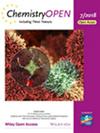通过 Suzukii-Miyaura 交叉偶联生成新的三环芳基喹唑啉衍生物。
IF 2.5
4区 化学
Q2 CHEMISTRY, MULTIDISCIPLINARY
引用次数: 0
摘要
报告了一些新的脱氧鸭嘴花碱酮(2,3-二氢吡咯并[2,1-b]喹唑啉-9(1H)-酮)和麦金唑啉酮(6,7,8,9-四氢-11H-吡啶并[2,1-b]喹唑啉-11-酮)衍生物,这些衍生物在 C7/C8 和 C5 处具有芳基取代基。这些化合物是同类化合物中罕见的代表,它们是以醋酸钯为催化剂,通过 7-溴-2,3-二氢[2,1-b]喹唑啉-9-(1H)-酮、5,7-二溴-2,3-二氢[2,1-b]喹唑啉-9-(1H)-酮或 8-溴ackinazolinone 与各自的芳硼酸之间的 Suzuki-Miyaura 交叉偶联反应高产制备的。对六种产物进行了光谱分析和 X 射线晶体结构分析。本文章由计算机程序翻译,如有差异,请以英文原文为准。
New Tricyclic Aryl Quinazoline Derivatives by Suzuki-Miyaura Cross-Coupling.
A number of new deoxyvasicinone (2,3-dihydropyrrolo[2,1-b]quinazolin-9(1H)-one) and mackinazolinone (6,7,8,9-tetrahydro-11H-pyrido[2,1-b]quinazolin-11-one) derivatives with aryl substituents at C7/C8 and at C5 are reported. These compounds are rare representatives of their kind and were prepared in high yields by Suzuki-Miyaura cross-coupling reactions between 7-bromo-2,3-dihydro[2,1-b]quinazoline-9-(1H)-one, 5,7-dibromo-2,3-dihydro[2,1-b]quinazoline-9-(1H)-one or 8-bromomackinazolinone and respective arylboronic acids with palladium acetate as the catalyst. The products were characterized spectroscopically and, in addition, by X-ray crystal structure analyses in six cases.
求助全文
通过发布文献求助,成功后即可免费获取论文全文。
去求助
来源期刊

ChemistryOpen
CHEMISTRY, MULTIDISCIPLINARY-
CiteScore
4.80
自引率
4.30%
发文量
143
审稿时长
1 months
期刊介绍:
ChemistryOpen is a multidisciplinary, gold-road open-access, international forum for the publication of outstanding Reviews, Full Papers, and Communications from all areas of chemistry and related fields. It is co-owned by 16 continental European Chemical Societies, who have banded together in the alliance called ChemPubSoc Europe for the purpose of publishing high-quality journals in the field of chemistry and its border disciplines. As some of the governments of the countries represented in ChemPubSoc Europe have strongly recommended that the research conducted with their funding is freely accessible for all readers (Open Access), ChemPubSoc Europe was concerned that no journal for which the ethical standards were monitored by a chemical society was available for such papers. ChemistryOpen fills this gap.
 求助内容:
求助内容: 应助结果提醒方式:
应助结果提醒方式:


